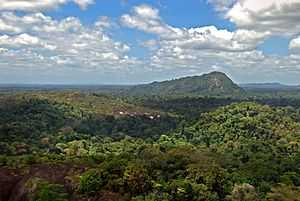Central Suriname Nature Reserve
| Central Suriname Nature Reserve | |
|---|---|
| Name as inscribed on the World Heritage List | |
|
View from the Voltzberg in the Central Suriname Nature Reserve | |
| Type | Natural |
| Criteria | ix, x |
| Reference | 1017 |
| UNESCO region | Latin America and the Caribbean |
| Inscription history | |
| Inscription | 2000 (24th Session) |
The Central Suriname Nature Reserve (Dutch: Centraal Suriname Natuurreservaat (CSNR)) was created in 1998 by Conservation International and the government of Suriname. It was designated a UNESCO World Heritage Site in 2000 for its pristine tropical rainforest ecosystem, and contains 16,000 square kilometres (6,178 sq mi) of both montane and lowland primary tropical forest including sections of the Guyana Highlands.
Some of the most outstanding features in Central Suriname Nature Reserve are several granite domes - uplifted monoliths of granite rising high above the surrounding rainforest. Barren surface of dark-colored granite is exposed to impact of Sun thus creating unique xerophytic biotope which includes also endemic plant species. The best known granite dome is the 245 m high Voltzberg.[1]
Other attractions include the Julianatop (1230 m), the highest mountain in Suriname, the Tafelberg (Table Mountain, 1026 meters), the Van Stockum Berg (360 m), Duivelsei (Devil's Egg), a rock seemingly balanced on the edge of a mountain.
References
- ↑ "Voltzberg - granite dome in tropical forest". Wondermondo. Retrieved 5 June 2010.
External links
 Media related to Central Suriname Nature Reserve at Wikimedia Commons
Media related to Central Suriname Nature Reserve at Wikimedia Commons Surinamese Rainforest travel guide from Wikivoyage
Surinamese Rainforest travel guide from Wikivoyage- UNESCO site: Central Suriname Nature Reserve
- Conservation International site: Central Suriname Nature Reserve
- Stinasu site: Central Suriname Nature Reserve
Coordinates: 4°0′0″N 56°30′0″W / 4.00000°N 56.50000°W
